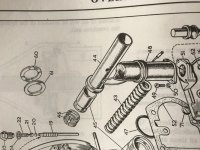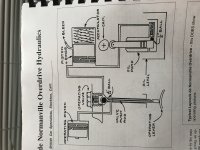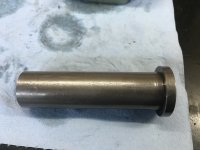AUSMHLY
Yoda
Offline
Hello,
I'm wondering why my 1964 BJ8 overdrive accumulator spring tube does not have the bleed hole.
I believe it's suppose to. (#44 in the diagram) Being I don't have the hole, how does that affect PSI?
I have about 450-470 PSI in and out of overdrive when the car is warmed up. Should be 470-490.
When OD is engaged, PSI drops 250 instantly 1 second, and returns to 450-470 in about 3 seconds. That's not what the article says should happen.
When I put it in neutral, hit the brakes, and turn off the engine, the PSI drops to 0 in about 10 seconds where I believe it should drop to about 250-300 and stay there for a several hours.
This is from the Healey technical archives, the overdrive:
Start the engine in neutral and adjust the idle to about 1500 RPM. Without feeding any gas, place the gearshift into 4th gear (OD off) while watching the gauge. The pressure should increase from 0 to 300 PSI in TWO TO THREE SECONDS. In another 10 seconds, the pressure should have gone from 300 to 470 PSI where it should remain constant. Keep the car running at 1500 RPM while watching the gauge - it should stay rock steady at 470 to 490 PSI.
Now engage OD while watching the gauge - it should drop about 100 PSI when OD kicks in, then climb back up to 470-490 in about 5 seconds. While watching the gauge, place the gearbox into neutral, hit the brakes, and turn off the engine. When the rear wheels stop turning, the pressure will drop slowly into the low 400's, then continue dropping at a rate of about l0 PSI per minute down to about 250-300 PSI where it should stay for several hours.
1) Was there a time when these didn't have the bleed hole? (#44 on the diagram)
2) Being mine does not have the hole, how is it affecting my system?
3) Would not having this hole have anything to do with not holding pressure when out of gear?
4) Why am I losing all PSI when out of gear?
I'm wondering why my 1964 BJ8 overdrive accumulator spring tube does not have the bleed hole.
I believe it's suppose to. (#44 in the diagram) Being I don't have the hole, how does that affect PSI?
I have about 450-470 PSI in and out of overdrive when the car is warmed up. Should be 470-490.
When OD is engaged, PSI drops 250 instantly 1 second, and returns to 450-470 in about 3 seconds. That's not what the article says should happen.
When I put it in neutral, hit the brakes, and turn off the engine, the PSI drops to 0 in about 10 seconds where I believe it should drop to about 250-300 and stay there for a several hours.
This is from the Healey technical archives, the overdrive:
Start the engine in neutral and adjust the idle to about 1500 RPM. Without feeding any gas, place the gearshift into 4th gear (OD off) while watching the gauge. The pressure should increase from 0 to 300 PSI in TWO TO THREE SECONDS. In another 10 seconds, the pressure should have gone from 300 to 470 PSI where it should remain constant. Keep the car running at 1500 RPM while watching the gauge - it should stay rock steady at 470 to 490 PSI.
Now engage OD while watching the gauge - it should drop about 100 PSI when OD kicks in, then climb back up to 470-490 in about 5 seconds. While watching the gauge, place the gearbox into neutral, hit the brakes, and turn off the engine. When the rear wheels stop turning, the pressure will drop slowly into the low 400's, then continue dropping at a rate of about l0 PSI per minute down to about 250-300 PSI where it should stay for several hours.
1) Was there a time when these didn't have the bleed hole? (#44 on the diagram)
2) Being mine does not have the hole, how is it affecting my system?
3) Would not having this hole have anything to do with not holding pressure when out of gear?
4) Why am I losing all PSI when out of gear?
Attachments
Last edited:

 Hi Guest!
Hi Guest!

 smilie in place of the real @
smilie in place of the real @
 Pretty Please - add it to our Events forum(s) and add to the calendar! >>
Pretty Please - add it to our Events forum(s) and add to the calendar! >> 


